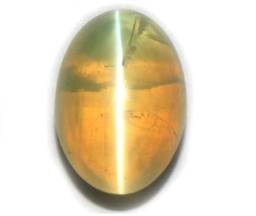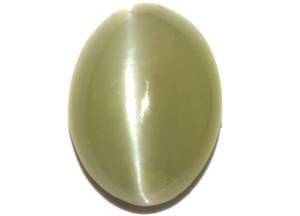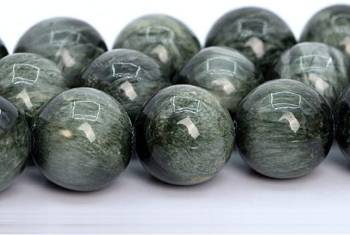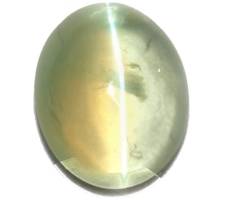The Mesmerizing World of Chatoyancy: A Deep Dive into the Cat’s Eye Effect in Gemstones.
Embark on a journey into the captivating world of chatoyancy, a rare optical phenomenon in which gemstones unveil a mesmerizing cat’s eye glow. This journey unravels the magic behind the unique shimmer, enthralling enthusiasts and collectors with its rarity and beauty.

2.34 Carats Chrysoberyl Cat’s Eye |

Chrysoberyl Cat’s Eye 1.60 Carats |
What is Chatoyancy, and How is it Manifested in Gemstones?
Chatoyancy is a rare optical phenomenon in the world of gemstones. The spectacle is renowned for its captivating cat’s eye effect. This unique visual miracle results from light reflecting off parallel inclusions within the stone. The synchronized reflection creates a luminous band that glides as the angle of light changes. The beauty of chatoyancy lies in its dynamic display, reminiscent of a cat’s pupil narrowing and widening.
The Science Behind the Cat’s Eye Effect:
The core of chatoyancy lies in its internal structure. In gemstones like chrysoberyl, the presence of rutile, composed mainly of titanium dioxide, plays a crucial role. These rutile inclusions align perpendicularly within the gemstone, catching and reflecting light to produce a distinct cat’s eye appearance. This alignment is critical, as it must match the gemstone’s crystal structure to create the desired effect.
Capturing Chatoyancy: The Role of Gemstone Cutting:
Achieving the perfect cat’s eye effect is a testament to the precision and skill of lapidaries. Gemstones are typically cut into a cabochon shape, featuring a rounded, flat base that enhances the interaction between light and the internal fibrous structures. High-quality specimens exhibit a sharply defined band of light that glides across the stone when viewed from different angles. On the other hand, lower-quality stones may display a less distinct or banded effect.
Varieties of Chatoyant Materials:
A wide range of gemstones can exhibit chatoyancy, though not every specimen will show the effect. Notable examples include chrysoberyl, tiger’s eye, cat’s eye quartz, and beryl varieties such as aquamarine. Each gemstone brings its unique version of the cat’s eye effect, contributing to the diversity and appeal of chatoyant gems in the jewelry world.
10MM Genuine Natural Green Chrysoberyl Cat Eye Beads (chatoyancy)
Unraveling the Mystery: The Science Behind Chatoyancy:
What Triggers Chatoyancy?
Chatoyancy emerges from light reflecting off needle-like inclusions within gemstones. These inclusions are typically fibrous or feature elongated hollow tubes parallel to each other. When light hits these inclusions, it scatters or reflects perpendicularly, creating a luminous streak or band. This phenomenon is distinct from luster, which pertains to a surface’s reflectance.
Crafting Gems to Showcase Chatoyancy:
Cabochon-cut gems best display the magic of chatoyancy. This cut, with a convex top and a flat base, aligns with the inclusions’ orientation, enhancing the cat’s eye effect. Achieving this requires precision, ensuring the inclusions run parallel to the cabochon’s base and follow the gem’s symmetry for maximum allure.
Gems Known for Chatoyancy:
Several gems exhibit chatoyancy, but not all specimens within these types will. Famous examples include chrysoberyl, known for its vivid cat’s eye effect, and tiger’s eye, a metamorphic rock displaying golden to brown hues. Other notable mentions are moonstone, sapphire, ruby, aquamarine, emerald, and labradorite, each offering unique expressions of chatoyancy.
The Role of Diffraction:
Some chatoyant gems also show diffraction, where light passing through coarse inclusions splits into spectral colors. This rare attribute adds another layer to the gem’s visual appeal, creating a mesmerizing display similar to a miniature rainbow within the stone.
Lights and Shadows: Optical Effect of Chatoyancy:
The Essence of Chatoyancy:
The chatoyancy effect, or the cat’s eye effect, is not just about surface shine; it’s about light dancing beneath the surface of gemstones. This phenomenon results from light reflecting off fibrous structures or needle-like parallel inclusions within the stone, such as rutile or hematite. These minute, aligned features create a concentrated band of light that appears to glide across the stone’s surface with movement. The effect, resembling the narrowing pupils of a cat’s eye in bright light, lends chatoyancy its name and allure.
Crafting the Illusion:
One must shape a gem into a cabochon cut to appreciate chatoyancy fully. This style, featuring a convex top and a flat base, aligns with the inclusions to maximize the visibility of the cat’s eye effect. The skill in cutting and polishing these stones is paramount, ensuring that the light-refracting fibrous inclusions run parallel to the base, enhancing the movement and depth of the light band.
A Spectrum of Chatoyant Gems:
While tiger’s eye and cat’s eye chrysoberyl are often celebrated for their chatoyancy, this mesmerizing effect is not limited to them. Various gems, including moonstone, sapphire, ruby, and even malachite, can exhibit chatoyancy under the right conditions. Each stone uniquely displays this optical marvel, from subtle glows to bold, linear luminescence.
Beyond Natural Stones:
Chatoyancy transcends natural gemstones, extending to synthetic materials and even glass designed to mimic this fascinating light play. These artificial creations offer a more accessible option for those enchanted by the cat’s eye effect. Still, they are mindful of the rarity and value of natural chatoyant gems.
A Closer Look at Cutting and Quality:
The journey from rough gem to polished marvel is meticulous, with cutters striving for orientations that bring out the best cat’s eye effect. A quality chatoyant gem is judged not only by the visibility and movement of its light band but also by the color and clarity of the stone itself. The finest examples balance a dynamic light play with exceptional color, capturing the essence of chatoyancy in every facet.
2.30 Carats Chrysoberyl Cat’s Eye
Comparing Chatoyancy with Other Phenomena: Asterism and Alexandrite Effect:
Understanding Chatoyancy:
Chatoyancy, also known as the cat’s eye effect, showcases a unique sheen that moves across the surface of a gemstone. This effect is a narrow band of light due to the reflection from parallel inclusions within the gem. When these inclusions are precisely aligned, they create a focused band of light that shifts position as the stone or the light source moves. Gems like chrysoberyl, tiger’s eye, and tourmaline are well-known for displaying this captivating phenomenon.
Asterism: The Starry Reflection:
Asterism, or the star effect, is a specific type of chatoyancy where the light reflection creates a star-like pattern on the gemstone’s surface. This phenomenon occurs when nature arranges the inclusions to intersect at particular angles, reflecting light to form a four-, six-, or twelve-pointed star. Star sapphire and star ruby are classic examples of gemstones that exhibit asterism, resulting from intersecting inclusions of rutile or hematite. The orientation and cut of the gem are critical in highlighting the star effect, making asterism a highly prized feature among collectors.
The Alexandrite Effect: A Play of Color:
While not a form of chatoyancy, the Alexandrite effect refers to a remarkable color change in gemstones seen under different lighting conditions. Scientists named this optical phenomenon after the gemstone alexandrite, which can appear green in daylight and red in incandescent light. The color change is due to the gem’s composition, which allows it to absorb and reflect different wavelengths of light depending on the lighting environment. Although alexandrite is the most renowned for this effect, other gems like sapphire, garnet, and diaspore can also exhibit similar color-changing properties.
Exploring Gemstones Exhibiting the Chatoyant Effect:
We can see this enchanting attribute in a variety of gems, from the well-known tiger’s eye to the luxurious chrysoberyl cat’s eye
The Classic Chatoyants: Chrysoberyl Cat’s Eye and Tiger’s Eye:
Chrysoberyl Cat’s Eye: The Pinnacle of Chatoyancy:
Chrysoberyl Cat’s Eye, revered for its captivating beauty, is a premier example of chatoyancy. This gemstone mesmerizes with a sharp, silken band of light that gracefully moves across its surface, mimicking the narrow pupil of a cat’s eye. Unique among chatoyants, Chrysoberyl Cat’s Eye owes its striking effect to tightly packed, parallel inclusions of rutile or silk. The precision in cutting this gem into a cabochon shape, with the dome aligned perfectly with the inclusions, accentuates its chatoyancy, making it a prized possession in the gem world.
Tiger’s Eye: The Metamorphic Marvel:
Tiger’s Eye, another classic chatoyant gemstone, offers a different allure. Originating from the transformation of crocidolite, a form of asbestos, into quartz, this metamorphic rock showcases an earthy blend of golden to red-brown hues. Its chatoyancy emerges from the fibrous structure of the crocidolite, preserved within the quartz, creating a captivating play of light. Unlike the focused band seen in Chrysoberyl Cat’s Eye, Tiger’s Eye displays a broader, more diffuse luminescence akin to the shifting light of the sun.
Distinctive Beauty and Value:
While both Chrysoberyl Cat’s Eye and Tiger’s Eye showcase the enchanting effect of chatoyancy, their appeal and value differ significantly. With its sharper, more defined cat’s eye, the Chrysoberyl Cat’s eye effect commands higher prestige and price. We use it in jewelry. On the other hand, Tiger’s Eye is beloved for its unique coloration and broader appeal, making it a popular choice for various decorative items. Together, these gemstones illustrate the diverse beauty of chatoyant gems, each offering a unique window into the dynamic interplay of light and mineral.
Unique Displays: Tourmaline, Moonstone, and Sapphire with Chatoyancy:
Tourmaline: A Spectrum of Chatoyancy:
Tourmaline, a gemstone celebrated for its extensive color range, also showcases the chatoyant effect, particularly in its cat’s-eye varieties. The chatoyancy in tourmaline results from light reflecting off parallel inclusions within the gem, creating a captivating eye effect that enhances its appeal. The quality of this effect is determined by the clarity of the visible eye and the stone’s body color, making each piece unique. The cutting technique, aiming to align the inclusions parallel to the cabochon’s base, is crucial in maximizing the chatoyant display.
Moonstone: Ethereal Glow:
Moonstone, known for its adularescence, occasionally exhibits chatoyancy, adding to its mystical allure. The phenomenon in moonstone creates a serene, glowing line across the stone that shifts with the light, contributing to its reputation for romance and mystique. The effect is more subtle than the stark bands in other gemstones. Still, it adds depth and interest to the captivating moonstone.
Sapphire: Rare and Refined Chatoyancy:
Sapphire, a corundum variety, is more commonly associated with asterism but can also display chatoyancy under rare circumstances. This effect in sapphire is not typically caused by the solid inclusions found in other chatoyant gems but rather by internal parallel fracture surfaces and fluid inclusions. Through these natural features, the intricate play of light provides a subtle yet remarkable cat’s eye effect. The orientation and cutting of the gemstone are critical to showcasing this phenomenon, revealing the skill and precision required to bring out the chatoyant band in sapphires.
In exploring the unique displays of chatoyancy in tourmaline, moonstone, and sapphire, we uncover how light and internal gemstone structures interact to produce this enchanting effect. Each gem offers a distinct version of chatoyancy, from the pronounced and sharp eye of tourmaline to the gentle glow of moonstone and the rare, refined band in sapphire. This diversity highlights the beauty and complexity of chatoyant gemstones. It underscores the importance of expert cutting to reveal their full potential.
The Rarity of Chatoyant Quartz and Apatite:
Chatoyant Quartz: A Glimpse into Earth’s Artistry:
Quartz, one of the most versatile minerals, sometimes exhibits chatoyancy, creating stunning visual effects. This optical phenomenon, often compared to a cat’s eye, arises from light reflecting off parallel inclusions within the stone. The classic examples of chatoyant quartz include varieties such as tiger’s eye, hawk’s eye, and bull’s eye, each distinguished by fibrous inclusions that give rise to its mesmerizing glow. These inclusions, acting like a series of parallel needles, generate a moving reflection band that captures the essence of chatoyancy.
Apatite: The Uncommon Cat’s Eye:
Apatite, a lesser-known gemstone that can also display chatoyancy, is coveted for its vivid colors and unique optical qualities. The chatoyant effect in apatite is not as commonly encountered as in other gemstones, making specimens with a clear, visible cat’s eye highly prized. Similar to other chatoyant gems, the effect in apatite is caused by the reflection of light off internal parallel growth channels or needle-like inclusions. This effect can make apatite, especially those with colors akin to chrysoberyl cat’s eye, highly sought after by collectors and jewelry designers. Properly cutting and polishing apatite are crucial to reveal its chatoyancy, enhancing its beauty and appeal.
Glass Imitations: A Note of Caution:
While natural chatoyant gems are treasured, the market also includes glass imitations designed to mimic this effect. These imitations, made from colored fiber optic glass, can be easily identified by examining the side view of the cabochons, revealing the artificial fibers responsible for their chatoyancy. Awareness and careful examination are essential when purchasing chatoyant gemstones to ensure authenticity.
The Mystique of Chatoyancy:
Both chatoyant quartz and apatite offer a glimpse into the diverse and enchanting world of gemstones, where light and minerals come together to create captivating visual effects. The rarity and distinctiveness of these gems and the craftsmanship in highlighting their chatoyancy underscore their appeal among gem enthusiasts and collectors. Whether naturally occurring or skillfully crafted, chatoyant gemstones continue to fascinate and inspire, embodying the timeless allure of nature’s artistry.
Understanding the Unique “Milk and Honey” Effect in Chatoyant Stones:
The “Milk and Honey” effect in chatoyant gemstones is a striking optical phenomenon that presents a sharp contrast of light and dark hues within the stone, reminiscent of its namesake. This effect is particularly pronounced under direct light, showcasing a vivid division that enhances the gem’s allure and perceived depth. It’s a hallmark of high-quality chatoyancy.
Deciphering the Dual Visual Impact: Light and Color Play in “Milk and Honey:”
The “Milk and Honey” effect in chatoyant stones like Chrysoberyl cat’s eye offers a captivating dual visual impact, blending light and color. This phenomenon occurs when light is directed towards the stone, causing one-half to illuminate with a rich honey color. In contrast, the other half displays a softer, milky appearance. Concentrated light sources make this striking contrast more pronounced with the chatoyant band positioned at right angles to the light. It showcases the stone’s intrinsic beauty and depth.
This unique effect not only underscores the rarity and appeal of the Chrysoberyl cat’s eye but also highlights the gem’s exceptional quality when the honey and milky zones are sharply defined. Skillful cutting and polishing are crucial to enhancing this effect.
Examples of Gemstones Exhibiting the “Milk and Honey” Phenomenon
The “Milk and Honey” effect is a remarkable phenomenon observed in chatoyant gemstones, offering a striking visual contrast. This section explores gemstones known for exhibiting this captivating feature.
Chrysoberyl Cat’s Eye: The Quintessence of Milk and Honey:
Chrysoberyl Cat’s Eye is perhaps the most famous bearer of the “Milk and Honey” effect. The effect is so pronounced and sought after in this gem that when light hits the stone, one side glows with a golden honey color while the other appears milky white. The clear demarcation and the sharp eye movement as the stone is rotated make Chrysoberyl Cat’s Eye a top-tier example of this phenomenon.
Tiger’s Eye: Earthy Interpretation:
While Tiger’s Eye primarily showcases chatoyancy, certain high-quality pieces can exhibit a version of the “Milk and Honey” effect. The effect is more subdued in these stones, with the fibrous structure creating an earthy, banded appearance that shifts in the light. The silky luster and rich brown and golden hues can mimic the “Milk and Honey” appearance under specific lighting conditions.
Apatite: A Rare Vision:
Apatite, especially in its rare cat’s eye variety, can display a “Milk and Honey” effect, though this is less common. The phenomenon in Apatite is typically more subtle than Chrysoberyl but adds depth and interest to this already intriguing gemstone. The contrast between Apatite’s milk and honey colors enhances its visual appeal and rarity.
Quartz Varieties: Broad Spectrum Display:
Certain varieties of Quartz, including Hawk’s Eye and some forms of Cat’s Eye Quartz, can show a diffused “Milk and Honey” effect. The variability in the inclusions and the size of the Quartz pieces mean that the effect can range from stark and noticeable to subtle and nuanced, offering a broad spectrum of appearances within the same mineral family.
| The Metal Platinum | Platinum Jewelry |
| Palladium Metal Attributes | Rhodium Metal Attributes |
| White Gold | Rose Gold |
| Silver And Sterling Silver | Titanium |
| Black Gold Jewelry |

